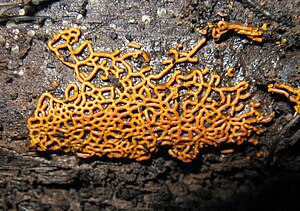Hemitrichia serpula
| Hemitrichia serpula | ||||||||||||
|---|---|---|---|---|---|---|---|---|---|---|---|---|

Hemitrichia serpula |
||||||||||||
| Systematics | ||||||||||||
|
||||||||||||
| Scientific name | ||||||||||||
| Hemitrichia serpula | ||||||||||||
| ( Scop. ) Rostaf. |
Hemitrichia Serpula is a slime mold from the family Trichiidae .
features
Macroscopic properties
Hemitrichia serpula forms typical yellow-brown plasmodiocarpia , which have a pronounced network structure. This can spread over an area of up to 100 square centimeters, but it is usually smaller. The fructifications are between 0.4 and 0.6 millimeters wide and high, with the mesh size 0.3 to 5 millimeters. A thin brown base ( hypothallus ) runs under the plasmodium .
The shell ( peridia ) consists of a simple layer that opens irregularly when ripe and disappears completely over time. It appears pale yellow in transmitted light. It is criss-crossed with fine streaks that branch out like branches and run in a meander shape . Sometimes they are also connected to one another like a network.
The scalp is colored golden yellow to orange in mass. It is elastic and can be lifted from the fruiting bodies, where it runs apart like threads of wool and does not break. The spores appear golden yellow in bulk. The plasmodium is initially white, but turns yellow as it matures.
Microscopic properties
The scalp is twisted, sometimes branched and has exposed ends. These are briefly pointed and have up to three thorns at the tip. The individual threads are between 5 and seven micrometers thick and tightly wrapped with three or four spiral strips. There are colorless spines three to seven micrometers long on them.
The spores have a 1 to 1.5 micrometer wide edge zone. Measured with these, they have an overall diameter of 10 to 14 micrometers. The surface is covered with mostly large, irregular net meshes, some of which are interrupted.
Similar species
The slime mold can hardly be confused with the eye-catching net pattern; The color and structure of the scalp are also characteristic.
ecology
Hemitrichia serpula is found mainly in late summer to autumn and in spring. Occasionally it also occurs in winter. The slime mold colonizes deciduous and coniferous wood, whereby hardwood is preferred. Socialization was observed with Hemitrichia calyculata , Hemitrichia clavata , Trichia persimilis , Trichia scabra , Trichia varia , Tubifera ferruginosa and Arcyria ferruginea as well as with species of the genus Cribraria .
distribution
Hemitrichia serpula is widespread worldwide, but is not often found everywhere. In Central Europe it is also only to be found scattered, but at least in Upper Austria it occurs frequently.
Systematics
Specimens with a smooth scalp are rarely found. These have been described as Hemitrichia serpula var. Tubiglabra .
literature
- Hermann Neubert , Wolfgang Nowotny , Karlheinz Baumann : The myxomycetes of Germany and the neighboring alpine region with special consideration of Austria . tape 1 . Karlheinz Baumann Verlag, Gomaringen 1993, ISBN 3-929822-00-8 .